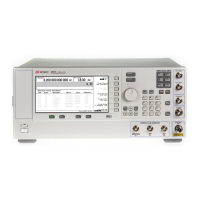E8257D/67D, E8663D PSG Signal Generators Service Guide
Troubleshooting
RF Path Description (Frequency Generation, Level Control, and Modulation)
1-99
RF Path Description (Frequency Generation, Level Control, and Modulation)
The RF path can divide, pass through, and multiply the A28 YIG Oscillator (YO) signal to generate the desired RF
frequency. Depending on models and options, the RF path includes hardware for amplitude, pulse, and digital (I/Q)
modulation and controls the RF output power level. The Synthesis /Reference Block Description provides additional
information on generating fundamental frequencies of 3.2 GHz to 10 GHz.
All RF signals originate from the A28 YIG Oscillator (YO) output frequencies of 3.2 GHz to 10 GHz. RF output
frequencies below 3.2 GHz are generated by dividing the YO signal on the A6 Frac–N and A8 Lowband Output
assembly. RF output frequencies between 3.2 and 10 GHz pass through the A29 20 GHz Doubler. RF output
frequencies between 10 to 20 GHz are generated by doubling the 5 to 10 GHz YO signal in the A29 20 GHz Doubler.
In 40 GHz analog models, RF output frequencies above 20 GHz are generated by doubling the 10 to 20 GHz signal
output of the A29 20 GHz Doubler in the A27 40 GHz Doubler. In analog models with output frequencies greater than
40 GHz, the A27 40 GHz Doubler is replaced with the A36 Quadraplier. The A36 Quadraplier generates all frequencies
above 20 GHz. The A36 Quadraplier contains two doublers. The first doubler is a 40 GHz doubler that doubles the 10
to 20 GHz from the A30 Modulation Filter to generate frequencies between 20 and 40 GHz. The second doubler in the
A36 Quadraplier doubles frequencies above 20 GHz (from the 40 GHz doubler) to generate frequencies above 40 GHz.
In vector models with frequencies above 20 GHz, the RF output is generated using the A37 Upconverter. The
A37 Upconverter contains a mixer, band pass filters, ALC and pulse modulation diodes, and amplifiers. The
A27 40 GHz Doubler is used to generate a 20 to 40 GHz LO input to the A37 Upconverter. The input to the
A27 40 GHz Doubler is an 11.4 to 19 GHz signal out of the A35 3–20 GHz IQ Modulator. A 5.7 to 9.5 GHz output from
the A35 3–20 GHz IQ Modulator is used for the A37 Upconverter IQ input. For frequencies of 20 to 28.5 GHz, the
difference product from the mixer is used and between 28.5 and 44 GHz, the summing mixing product is used.
Analog Model Hardware
In analog models, the RF Path comprises the following:
•A6 Frac–N
•A8 Output
• A12 Fast Pulse Modulation (Option UNW)
• A27 40 GHz Doubler (40 GHz models)
• A29 20 GHz Doubler
• A30 Modulation Filter
• A36 Quadraplier (> 40 GHz models)
• A38 Switch Filter (< 3.2 GHz if Option 1EH is installed)
• A43 Lowband Amp Filter
• AT1 Attenuator (if Option 1E1 is installed). Analog models have a 90 dB step attenuator and vector models have a
115 dB step attenuator.
Analog model option hardware includes:
• a removable compact flash drive
1
(Option 008) for external waveform storage
Vector Model Hardware
In addition to the analog hardware, vector models add the following hardware:
• A13 I/Q Multiplexer
• A27 40 GHz Doubler (> 20 GHz models)
• A35 3–20 GHz I/Q Modulator
• A37 44 GHz Upconverter (> 20 GHz models)
Vector model option hardware includes:
• a baseband generator (Option 602) for internal I/Q waveform generation
• an internal hard drive
2
(Option 005) for internal waveform storage (discontinued)
• a removable compact flash drive
3
(Option 009) for external waveform storage
Assemblies that differ between vector and analog models include:
• an A8 Output assembly that includes an I/Q modulator for frequencies below 3.2 GHz
• an A19 Power Supply and A31 Motherboard that can handle increased power requirements
1
Instruments with serial prefix ≥ 4829.
2
Instruments with serial prefix < 4829.
3
Instruments with serial prefix ≥ 4829.

